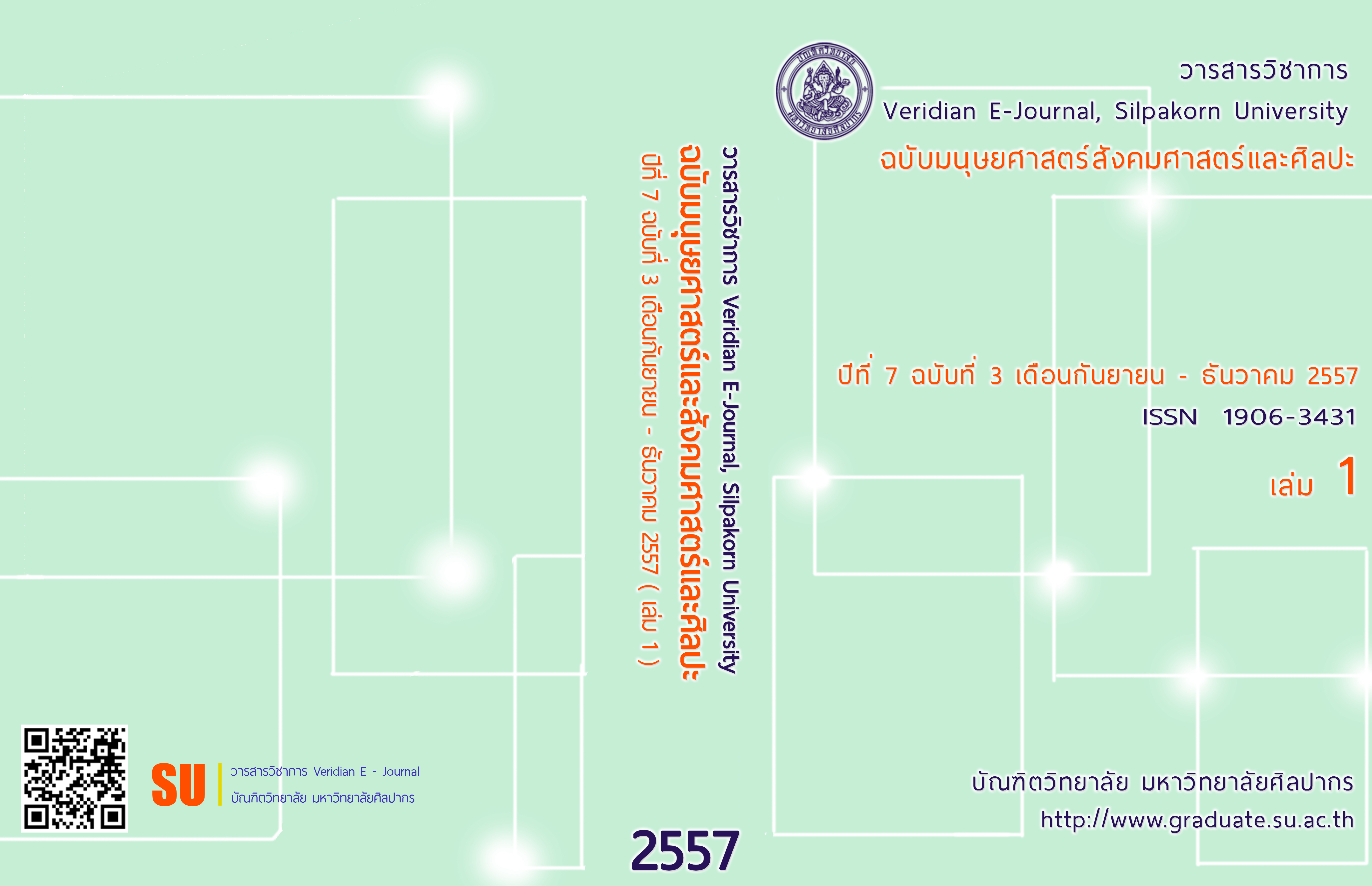การประเมินโครงการส่งเสริมเด็กดีมีคุณธรรมเข้าศึกษามหาวิทยาลัยเกษตรศาสตร์ วิทยาเขตกำแพงแสน/Evaluation of Good Children's Moral Project in Kasetsart University, Kamphaeng-Saen Campus
Main Article Content
Abstract
การวิจัยเรื่อง การประเมินโครงการส่งเสริมเด็กดีมีคุณธรรมเข้าศึกษามหาวิทยาลัยเกษตรศาสตร์ วิทยาเขตกำแพงแสน มีวัตถุประสงค์ 1)เพื่อประเมินผลการดำเนินงานของโครงการด้านบริบท ปัจจัยนำเข้า กระบวนการผลผลิต และผลกระทบ 2)เพื่อศึกษาปัญหา อุปสรรคการดำเนินโครงการ 3)เพื่อศึกษาแนวทาง และหลักเกณฑ์การประเมินการรับเข้าศึกษาต่อในระดับอุดมศึกษาในโครงการโควตาแบบพิเศษ โดยมีผู้ให้ข้อมูลของการวิจัยครั้งนี้จำนวน 6 กลุ่ม ได้แก่ 1)กลุ่มผู้บริหารมหาวิทยาลัยและสำนักงานเขตพื้นที่การศึกษา 2)กลุ่มประธานหลักสูตร 3)กลุ่มคณะกรรมการดำเนินงาน 4)กลุ่มนิสิตปัจจุบัน 5)กลุ่มบัณฑิต และ 6)กลุ่มผู้ใช้บัณฑิต ในการประเมินโครงการครั้งนี้ประยุกต์ใช้รูปแบบการประเมินแบบซิป (CIPPI Model) ของสตัฟเฟิลบีม (Stufflebeam) โดยใช้ระเบียบวิธีวิจัยแบบผสมผสาน (Mixed Method Research) ทั้งวิธีการเชิงปริมาณ (Quantitative Research) และวิธีการเชิงคุณภาพ (Qualitative Research) เครื่องมือในการศึกษาและเก็บรวบรวมข้อมูล ได้แก่ แบบสอบถาม และแบบสัมภาษณ์ ในการวิเคราะห์ข้อมูลเชิงปริมาณใช้สถิติแจกแจงความถี่ ค่าร้อยละ (%) ค่าเฉลี่ย ( ) และส่วนเบี่ยงเบนมาตรฐาน (SD) ส่วนการวิเคราะห์ข้อมูลเชิงคุณภาพใช้การวิเคราะห์และสรุปประเด็นสำคัญจากการสัมภาษณ์ ผลการวิจัยพบว่า
1. การประเมินบริบท ด้านวัตถุประสงค์ พบว่า มีความเหมาะสมสอดคล้องกับนโยบายของกระทรวงศึกษาธิการในระดับมากถึงมากที่สุด ( = 4.10-4.67) ด้านวิสัยทัศน์ พันธกิจของมหาวิทยาลัย และนโยบายของสำนักงานเขตพื้นที่การศึกษา พบว่า โครงการมีความสอดคล้องในระดับมาก ( = 4.05- 4.40) ด้านความต้องการของผู้เรียน พบว่า โครงการมีความสอดคล้องกับความต้องการและความสนใจของผู้เรียนในระดับมากถึงมากที่สุด ( = 3.71-4.52)
2. การประเมินปัจจัยนำเข้า ด้านคุณสมบัติและเกณฑ์การคัดเลือก พบว่า มีความเหมาะสมในระดับมาก ( = 4.00-4.42) ด้านความรู้ของนิสิตต่อการมาศึกษาต่อในระดับปริญญาตรี พบว่า มีเพียงพอในระดับมาก ( = 3.52- 4.38) ด้านปัจจัยสนับสนุนโครงการ ได้แก่ บุคลากร วัสดุ อุปกรณ์ สิ่งอำนวยความสะดวก และงบประมาณ พบว่า มีความเหมาะสมและเพียงพอในการดำเนินโครงการในระดับมาก ( = 3.53-4.29) ด้านจำนวนการรับนิสิต พบว่า มีความเหมาะสมสอดคล้องกับความต้องการในระดับมาก ( =3.74-4.22) ด้านกระบวนการคัดเลือกของสำนักงานเขตพื้นที่การศึกษา พบว่า มีความเหมาะสมในระดับมาก ( = 4.24-4.26) ด้านประชาสัมพันธ์การรับสมัคร พบว่า มีความเหมาะสมในระดับมาก ( = 3.58-4.07)
3. การประเมินกระบวนการ ด้านการดำเนินการจัดโครงการ ได้แก่ ระยะเวลาและขั้นตอนในการรับสมัคร ระยะเวลาการสอบสัมภาษณ์ ประกาศผลสอบคัดเลือก ขั้นตอนการสอบสัมภาษณ์และรายงานตัว พบว่า มีความเหมาะสมในระดับมาก ( = 3.58-4.08) ด้านการติดตามและประเมินผลการจัดโครงการ พบว่า มีความเหมาะสมในระดับมาก ( = 3.61-4.24) ด้านบริหารจัดการโครงการ ได้แก่ การปฐมนิเทศนิสิต ระบบการให้คำปรึกษาและการจัดกิจกรรมการเรียนการสอนที่ส่งเสริมความเป็นเด็กดีมีคุณธรรมให้กับนิสิตโครงการ พบว่ามีความเหมาะสมในระดับมาก ( = 3.65-4.30)
4. การประเมินผลผลิต ด้านคุณลักษณะบัณฑิตที่พึงประสงค์ ได้แก่ ทักษะความรู้ความสามารถในเนื้อหารายวิชา คุณลักษณะ/ความประพฤติ ทักษะการปฏิบัติ ทักษะภาษาต่างประเทศทักษะความเป็นผู้นำ ค่านิยมที่เหมาะสมต่อการดำเนินชีวิต ศักยภาพการเรียนรู้/แสวงหาความรู้ และพัฒนาศักยภาพของตนเอง พบว่ามีความเหมาะสมในระดับปานกลางถึงมาก ( = 3.19-4.42) ด้านผลการเรียนของนิสิต พบว่า ผลการเรียนของนิสิตโครงการอยู่ในเกณฑ์ดีในระดับมาก ( =3.52-3.84) ด้านภาวะการได้งานทำของบัณฑิต พบว่า สอดคล้องกับความต้องการของนายจ้างอยู่ในระดับมาก ( = 4.21) ด้านการขยายโอกาสทางการศึกษา พบว่า ผลของการจัดโครงการนี้ทำให้เกิดการขยายโอกาสทางการศึกษาในระดับมากถึงมากที่สุด ( = 3.90-4.81)
5. การประเมินผลกระทบ จากผลประเมินความพึงพอใจของผู้ใช้บัณฑิต ได้แก่ ด้านคุณธรรม จริยธรรม ด้านความรู้ ด้านทักษะทางปัญญา ด้านทักษะความสัมพันธ์ระหว่างบุคคลและความรับผิดชอบ และด้านทักษะการวิเคราะห์เชิงตัวเลข การสื่อสาร และการใช้เทคโนโลยี พบว่า มีความพึงพอใจในระดับมาก ( = 4.02-4.40)
Abstract
The research on the Evaluation of Good Children’s Moral Project in Kasetsart University, Kamphaeng-Saen Campus has the objectives as follows;
1) To evaluate the performance of Project in terms of contexts, inputs, production processes, and impacts;
2) To study the problems and obstacles of Project; and
3) To study the direction and evaluation criteria of university’s admission as special quota in the Project. The data providers in this research were split into 6 groups i.e. 1) The executives of university and educational service area office, 2) chairpersons of programs, 3) members of working committee, 4) existing students, 5) graduates, and 6) users of graduate.
This evaluation applied CIPPI Model belonging to Stufflebeam based on the mixed method research from quantitative research and qualitative research. The research tool and data collection were questionnaire and interview. The qualitative analysis applied frequency distribution, percentage (%), average ( ), and standard deviation (SD). The qualitative analysis which was conducted based on analyzing and summarizing important points from the interview provided the following results.
- The context analysis of objectives were corresponding to the policy of the Ministry of Education in the high to the highest levels ( = 4.10-4.67). The visions, missions of university, and policies of educational service area office of the Project had correspondence in the high level ( = 4.05- 4.40). The project aligned with the demand and interest of students in the high to the highest levels ( = 3.71-4.52).
2. The evaluation of the input in relation to qualification and selection criteria showed high suitability ( = 4.00-4.42). The adequacy of students’ knowledge for their further study in the bachelor’s degree was in high level ( = 3.52- 4.38). The supporting factors for the Project which were personnel, materials, equipment, facilities, convenience, and budget were suitable and adequate in high level ( = 3.53-4.29). The number of admitted students were appropriate and aligned with the demand in the high level ( =3.74-4.22). The screening process of educational service area office was appropriate in high level ( = 4.24-4.26). The promotions of application were appropriate in high level ( = 3.58-4.07).
3. The evaluation of project management’s procedures consisted of period and process of application, length of interview, announcement of screening results, and process of interview and reporting oneself were suitable in high level ( = 3.58-4.08). Monitoring and evaluating the results of project was appropriate in high level ( = 3.61-4.24). The project management including orientations, counseling system, lessons and activities arranged to enhance morality for students in the project was suitable in high level ( = 3.65-4.30).
4. The evaluation of outcomes in terms of the desirable graduate covering knowledge and ability skills in subjects, characteristics/behaviors, performance skills, foreign language skills, leadership skills, appropriate value for life, potential of learning /seeking knowledge and developing individual capability was appropriate in the middle to high level ( = 3.19-4.42). The studying performance of learners in the project was good in the high level ( = 3.52-3.84). The job acquisition of graduate which was in line with the requirements of employer was in the high level ( = 4.21). The project brought about new educational opportunities in the high to the highest levels ( = 3.90-4.81).
5. The evaluation of impact based on the satisfaction of graduate users i.e. morality and virtue, knowledge, skills, interpersonal skills, responsibilities, and critical thinking skills in terms of number, communication, and technology showed satisfaction in the high level ( = 4.02-4.40).